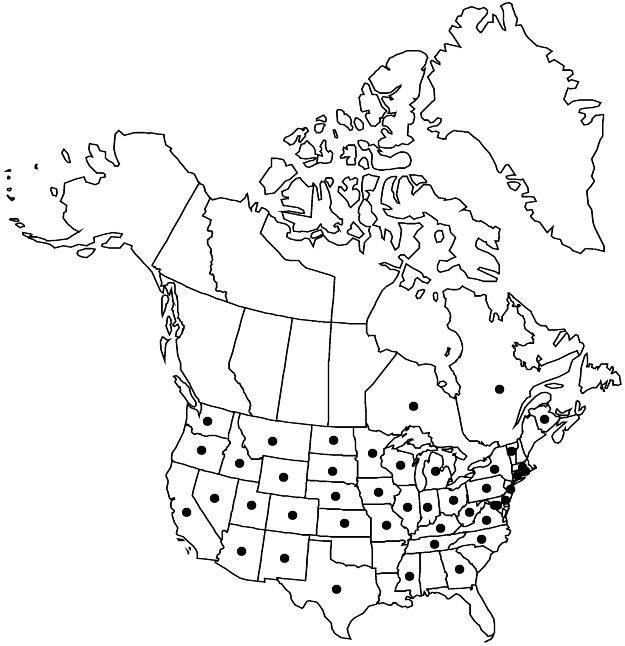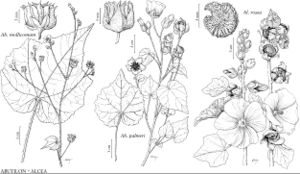Difference between revisions of "Alcea rosea"
Sp. Pl. 2: 687. 1753.
FNA>Volume Importer |
FNA>Volume Importer |
||
| Line 22: | Line 22: | ||
|name=Alcea ficifolia | |name=Alcea ficifolia | ||
|authority=Linnaeus | |authority=Linnaeus | ||
| − | }}{{Treatment/ID/Synonym | + | }} {{Treatment/ID/Synonym |
|name=A. glabrata | |name=A. glabrata | ||
|authority=Alefeld | |authority=Alefeld | ||
| − | }}{{Treatment/ID/Synonym | + | }} {{Treatment/ID/Synonym |
|name=Althaea ficifolia | |name=Althaea ficifolia | ||
|authority=(Linnaeus) Cavanilles | |authority=(Linnaeus) Cavanilles | ||
| − | }}{{Treatment/ID/Synonym | + | }} {{Treatment/ID/Synonym |
|name=A. mexicana | |name=A. mexicana | ||
|authority=Kunze | |authority=Kunze | ||
| − | }}{{Treatment/ID/Synonym | + | }} {{Treatment/ID/Synonym |
|name=A. rosea | |name=A. rosea | ||
|authority=(Linnaeus) Cavanilles | |authority=(Linnaeus) Cavanilles | ||
| − | }}{{Treatment/ID/Synonym | + | }} {{Treatment/ID/Synonym |
|name=A. rosea var. sinensis | |name=A. rosea var. sinensis | ||
|authority=(Cavanilles) S. Y. Hu | |authority=(Cavanilles) S. Y. Hu | ||
| − | }}{{Treatment/ID/Synonym | + | }} {{Treatment/ID/Synonym |
|name=A. sinensis | |name=A. sinensis | ||
|authority=unknown | |authority=unknown | ||
| Line 55: | Line 55: | ||
|elevation=0–3000 m | |elevation=0–3000 m | ||
|distribution=N.B.;Ont.;Que.;Ariz.;Calif.;Colo.;Conn.;Del.;D.C.;Ga.;Idaho;Ill.;Ind.;Iowa;Kans.;Ky.;Md.;Mass.;Mich.;Minn.;Miss.;Mo.;Mont.;Nebr.;Nev.;N.J.;N.Mex.;N.Y.;N.C.;N.Dak.;Ohio;Oreg.;Pa.;R.I.;S.Dak.;Tenn.;Tex.;Utah;Vt.;Va.;Wash.;W.Va.;Wis.;Wyo.;Asia (China);introduced also nearly worldwide. | |distribution=N.B.;Ont.;Que.;Ariz.;Calif.;Colo.;Conn.;Del.;D.C.;Ga.;Idaho;Ill.;Ind.;Iowa;Kans.;Ky.;Md.;Mass.;Mich.;Minn.;Miss.;Mo.;Mont.;Nebr.;Nev.;N.J.;N.Mex.;N.Y.;N.C.;N.Dak.;Ohio;Oreg.;Pa.;R.I.;S.Dak.;Tenn.;Tex.;Utah;Vt.;Va.;Wash.;W.Va.;Wis.;Wyo.;Asia (China);introduced also nearly worldwide. | ||
| − | |discussion=<p>Alcea rosea is a showy and popular ornamental that is essentially cosmopolitan in cultivation. The species is thought to have originated in the southwestern provinces of China but is apparently not known in the wild. It occasionally escapes and naturalizes in disturbed temperate areas nearly worldwide. However, it is often difficult to determine if a given specimen was cultivated or an established adventive. Plants with more deeply lobed leaves and rose-pink flowers have been called A. ficifolia; plants in cultivation under this name are most likely a mix of A. rosea and A. rugosa or of hybrid origin.</p> | + | |discussion=<p><i>Alcea rosea</i> is a showy and popular ornamental that is essentially cosmopolitan in cultivation. The species is thought to have originated in the southwestern provinces of China but is apparently not known in the wild. It occasionally escapes and naturalizes in disturbed temperate areas nearly worldwide. However, it is often difficult to determine if a given specimen was cultivated or an established adventive. Plants with more deeply lobed leaves and rose-pink flowers have been called A. ficifolia; plants in cultivation under this name are most likely a mix of <i>A. rosea</i> and <i>A. rugosa</i> or of hybrid origin.</p> |
|tables= | |tables= | ||
|references= | |references= | ||
| Line 80: | Line 80: | ||
|publication year=1753 | |publication year=1753 | ||
|special status=Selected by author to be illustrated;Introduced;Weedy | |special status=Selected by author to be illustrated;Introduced;Weedy | ||
| − | |source xml=https://jpend@bitbucket.org/aafc-mbb/fna-data-curation.git/src/ | + | |source xml=https://jpend@bitbucket.org/aafc-mbb/fna-data-curation.git/src/8f726806613d60c220dc4493de13607dd3150896/coarse_grained_fna_xml/V6/V6_407.xml |
|subfamily=Malvaceae subfam. Malvoideae | |subfamily=Malvaceae subfam. Malvoideae | ||
|genus=Alcea | |genus=Alcea | ||
Revision as of 17:47, 18 September 2019
Plants 1–2.5+ m, roughly stellate-hairy to hirsute. Leaves: stipules ovate, 8 mm, apically 3-lobed; petiole equaling or longer than blade; blade suborbiculate to 5–7-angled or shallowly triangular-lobed, sometimes more deeply channeled and winged dorsally, 6–8 mm. Seeds tuberculate or not, often minutely hairy. 2n = 42.
Phenology: Flowering May–Oct; fruiting Jun–Oct.
Habitat: Disturbed sites, roadsides, vacant lots
Elevation: 0–3000 m
Distribution

N.B., Ont., Que., Ariz., Calif., Colo., Conn., Del., D.C., Ga., Idaho, Ill., Ind., Iowa, Kans., Ky., Md., Mass., Mich., Minn., Miss., Mo., Mont., Nebr., Nev., N.J., N.Mex., N.Y., N.C., N.Dak., Ohio, Oreg., Pa., R.I., S.Dak., Tenn., Tex., Utah, Vt., Va., Wash., W.Va., Wis., Wyo., Asia (China), introduced also nearly worldwide.
Discussion
Alcea rosea is a showy and popular ornamental that is essentially cosmopolitan in cultivation. The species is thought to have originated in the southwestern provinces of China but is apparently not known in the wild. It occasionally escapes and naturalizes in disturbed temperate areas nearly worldwide. However, it is often difficult to determine if a given specimen was cultivated or an established adventive. Plants with more deeply lobed leaves and rose-pink flowers have been called A. ficifolia; plants in cultivation under this name are most likely a mix of A. rosea and A. rugosa or of hybrid origin.
Selected References
None.
